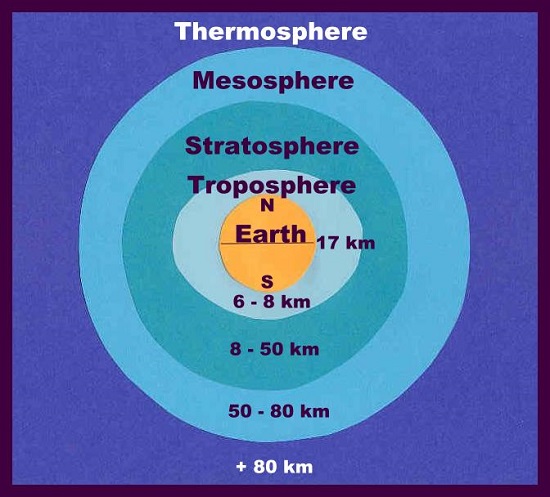the Earth's atmosphere
What is Earth's Atmosphere?
Gases surrounding our planet create our atmosphere
Earth's atmosphere is the layer of gases that surrounds our planet. Gravity keeps the gases from drifting off into space. Three-quarters of the atmosphere is located within 11 kilometers of the Earth's surface. The atmosphere thins out as Earth's gravitational pull decreases. The atmosphere becomes thinner and thinner as the distance from Earth increases.

Layers of the atmosphere
Earth's atmosphere and outer space
Boundary between the atmosphere and outer space
There is no true boundary between the Earth's atmosphere and outer space. At 120 km above the Earth noticeable effects can be detected on spacecraft as they re-enter our atmosphere. The Karmin line is 100 km (62 mi) above the Earth. It is considered by some scientists as the boundary between our atmosphere and outer space.
The Atmosphere's structure
Earth's atmosphere has structure and distinct layers
The Earth's atmosphere has structure and distinct layers. Each layers has specific characteristics that include composition and temperature. There are five major divisions of our atmosphere that reach from the surface of the Earth upward to outer space.

People have been looking up at the heavens while sitting around campfires for thousands of years. Today 12 men have walked on the Moon. Our book on space includes chapters on our Solar System, the Moon, life cycle of stars and the Hubble Telescope. Each chapter contains written information, quiz and an activity about space. Myrna

Click for More Information and to Order
Troposphere
Extent of the troposphere
The troposphere extends from the surface of the Earth upward 9 km (30,000 ft). The Earth's surface warms this layer of the atmosphere creating warm air thermals that mix the air in this layer. The temperature of the air decreases with altitude 6.5 degrees Celsius for each kilometer above the Earth's surface.
Height of troposphere at the equator and the poles
The height of the troposphere is greater at the equator than at the poles. The temperature is -45 degrees at the poles and -75 degrees Celsius over the equator. The air that we breathe is suitable for life on our planet only in the troposphere.
Stratosphere
The stratosphere begins above the tropopause which is the boundary between these two parts of the atmosphere. It extends to 51 kilometers (170,000 feet) above the Earth. The air increase in temperature in this layer as the ozone molecules absorb ultraviolet radiation from the Sun.
Mesosphere
The mesosphere extends from the upper boundary of the stratosphere up to 85 kilometers (280,000 feet) above the Earth. Shooting stars (meteors usually burn up in the part of the atmosphere. It is also the coldest place on Earth. At the boundary with the thermosphere the average temperature is -85 degrees Celsius. Water vapor is frozen in this layers forming ice clouds.
Thermosphere
Temperature in the thermosphere
The temperature in the thermosphere increases until it reaches the thermopause where it remains constant. The temperature at in this layer can rise to 1,500 degrees Celsius. The molecules are so far apart they can travel a kilometer without striking another molecule.
Aurora Borealis
The Aurora Borealis occurs in this layer and the International Space Station is located in the thermosphere. The upper limit of this layer varies with solar activity from 350 to 800 km above the Earth. The Karmin line lies in the lower part of the thermosphere.
Exosphere
The exosphere contains hydrogen and helium. The individual particles are spaced so far apart they can travel hundreds of kilometers before striking another molecule. The particles migrate into and out of the solar wind in this part of the atmosphere.
KIDS FUN Science Bookstore
Check out Myrna Martin's award winning textbooks, e-books, videos and rock sets. The Kids Fun Science Bookstore covers a wide range of earth science topics. Click here to browse.










